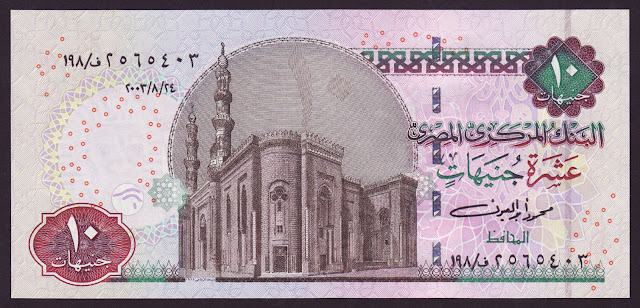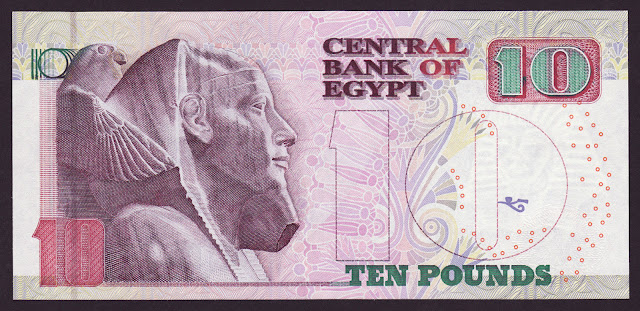Egypt banknotes 10 Pounds banknote 2003
Central Bank of Egypt
Obverse: Al-Rifa'i Mosque at Cairo at center
Back: Statue of Pharaoh Chefren (Pharaoh Khafre);
Watermark: The statue and mask of Pharaoh King Tutankhamun.
Original Size: 150 x 70 mm
Texts: Central Bank of Egypt; Ten Pounds.
Egypt Banknotes - Egyptian Paper Money
1978-2008 Issue
25 Piastres 50 Piastres 1 Pound 5 Pounds 10 Pounds
20 Pounds 100 Pounds
1994-2014 Issue
50 Piastres 5 Pounds 10 Pounds 20 Pounds 50 Pounds
100 Pounds 200 Pounds
25 Piastres 50 Piastres 1 Pound 5 Pounds 10 Pounds
20 Pounds 100 Pounds
1994-2014 Issue
50 Piastres 5 Pounds 10 Pounds 20 Pounds 50 Pounds
100 Pounds 200 Pounds
Al-Rifa'i Mosque
Al-Rifa'i Mosque (transliterated also as Al-Rifai, Al-Refai, Al-Refa'i, and named in English the Royal Mosque), is located in Cairo, Egypt, in Midan al-Qal'a, adjacent to the Cairo Citadel. The building is located opposite the Mosque-Madrassa of Sultan Hassan, which dates from around 1361, and was architecturally conceived as a complement to the older structure. This was part of a vast campaign by the 19th century rulers of Egypt to both associate themselves with the perceived glory of earlier periods in Egypt's Islamic history and modernize the city. The mosque was constructed next to two large public squares and off of several European style boulevards constructed around the same time.
The Al-Rifa'i Mosque was constructed in two phases over the period between 1869 and 1912 when it was finally completed. It was originally commissioned by Khushyar Hanim, the mother of the 19th century Khedive Isma'il Pasha to expand and replace the preexisting zawiyya (shrine) of the medieval era Islamic saint Ahmad al-Rifa'i. The zawiyya was a pilgrimage site for locals who believed that the tomb had mystical healing properties. Khushayer envisioned a dual purpose for the new structure as a house for sufi relics and a mausoleum for the royal family of Egypt. Over the course of its construction the architect, design, and purpose were changed.
The original architect was Husayn Fahmi Pasha al-Mi'mar, a distant cousin in the dynasty founded by Muhammad Ali in 1803. He died during the first phase of construction, and work was halted after Khedive Isma'il Pasha abdicated in 1880. Khushayar Hanim herself died in 1885, and work was not resumed until 1905 when the Khedive Abbas Hilmi II ordered its completion. Work was supervised by the Hungarian architect Max Herz, head of the Committee for the Conservation of Arab Monuments in Cairo.
Style
The building itself is a melange of styles taken primarily from the Mamluk period of Egyptian history, including its dome and minaret. The building contains a large prayer hall as well as the shrines of al-Rifa'i and two other local saints, Ali Abi-Shubbak and Yahya al-Ansari.
Usage
The mosque is the resting place of Khushyar Hanim and her son Isma'il Pasha, as well as numerous other members of Egypt's royal family, including King Farouk, Egypt's last reigning king, whose body was interred here after his death in Rome in 1965. The mosque served briefly as the resting place of Reza Shah Pahlavi of Iran, who died in exile in South Africa in 1944, and was returned to Iran after World War II. Part of the burial chamber is currently occupied by Reza Shah's son Mohammed Reza Pahlavi, who died in Cairo in July 1980.
Khafra (also read as Khafre, Khefren and Chephren) was an ancient Egyptian king (pharaoh) of 4th dynasty during the Old Kingdom. He was the son of Khufu and the throne successor of Djedefre. According to the ancient historian Manetho Khafra was followed by king Bikheris, but according to archaeological evidences he was rather followed by king Menkaure. Khafra was the builder of the second largest pyramid of Giza. Some of the Egyptologists also credit him with the building of the Great Sphinx, but this is highly disputed. There is not much known about Khafra, except the historical reports of Herodotus, who describes him as a cruel and heretic ruler, who kept the Egyptian temples closed after Khufu had sealed them.

